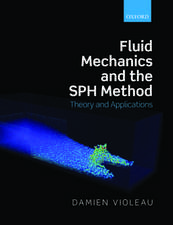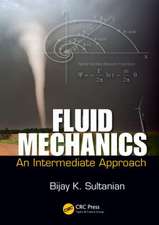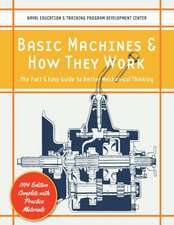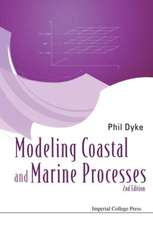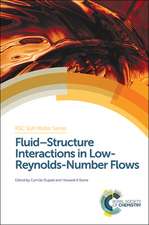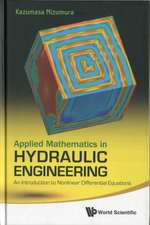Offshore and Coastal Modelling: Coastal and Estuarine Studies, cartea 12
Editat de P.P.G. Dyke, A. O. Moscardini, E.H. Robsonen Limba Engleză Paperback – 11 mar 1985
Din seria Coastal and Estuarine Studies
- 8%
 Preț: 502.60 lei
Preț: 502.60 lei - 15%
 Preț: 641.53 lei
Preț: 641.53 lei - 15%
 Preț: 636.45 lei
Preț: 636.45 lei - 15%
 Preț: 642.83 lei
Preț: 642.83 lei -
 Preț: 393.90 lei
Preț: 393.90 lei - 15%
 Preț: 655.27 lei
Preț: 655.27 lei -
 Preț: 408.16 lei
Preț: 408.16 lei -
 Preț: 390.25 lei
Preț: 390.25 lei -
 Preț: 393.74 lei
Preț: 393.74 lei - 15%
 Preț: 637.59 lei
Preț: 637.59 lei - 15%
 Preț: 638.57 lei
Preț: 638.57 lei -
 Preț: 381.98 lei
Preț: 381.98 lei -
 Preț: 398.53 lei
Preț: 398.53 lei - 15%
 Preț: 642.51 lei
Preț: 642.51 lei -
 Preț: 399.29 lei
Preț: 399.29 lei -
 Preț: 389.70 lei
Preț: 389.70 lei - 15%
 Preț: 647.08 lei
Preț: 647.08 lei - 15%
 Preț: 652.17 lei
Preț: 652.17 lei -
 Preț: 391.79 lei
Preț: 391.79 lei - 18%
 Preț: 948.79 lei
Preț: 948.79 lei - 15%
 Preț: 642.68 lei
Preț: 642.68 lei -
 Preț: 386.00 lei
Preț: 386.00 lei - 15%
 Preț: 647.73 lei
Preț: 647.73 lei - 18%
 Preț: 974.35 lei
Preț: 974.35 lei - 18%
 Preț: 957.44 lei
Preț: 957.44 lei - 15%
 Preț: 638.89 lei
Preț: 638.89 lei - 15%
 Preț: 657.08 lei
Preț: 657.08 lei - 15%
 Preț: 650.86 lei
Preț: 650.86 lei - 15%
 Preț: 633.19 lei
Preț: 633.19 lei - 15%
 Preț: 638.24 lei
Preț: 638.24 lei -
 Preț: 382.36 lei
Preț: 382.36 lei - 15%
 Preț: 639.08 lei
Preț: 639.08 lei - 30%
 Preț: 408.28 lei
Preț: 408.28 lei - 31%
 Preț: 317.49 lei
Preț: 317.49 lei
Preț: 394.87 lei
Nou
Puncte Express: 592
Preț estimativ în valută:
75.57€ • 78.60$ • 62.39£
75.57€ • 78.60$ • 62.39£
Carte tipărită la comandă
Livrare economică 12-26 aprilie
Preluare comenzi: 021 569.72.76
Specificații
ISBN-13: 9780387960548
ISBN-10: 0387960546
Pagini: 399
Ilustrații: IX, 399 p. 11 illus.
Dimensiuni: 155 x 235 x 21 mm
Greutate: 0.58 kg
Ediția:Softcover reprint of the original 1st ed. 1985
Editura: Springer
Colecția Springer
Seria Coastal and Estuarine Studies
Locul publicării:New York, NY, United States
ISBN-10: 0387960546
Pagini: 399
Ilustrații: IX, 399 p. 11 illus.
Dimensiuni: 155 x 235 x 21 mm
Greutate: 0.58 kg
Ediția:Softcover reprint of the original 1st ed. 1985
Editura: Springer
Colecția Springer
Seria Coastal and Estuarine Studies
Locul publicării:New York, NY, United States
Public țintă
ResearchCuprins
1 Modelling in Offshore and Coastal Engineering.- 2 Tides, Storm Surges and Coastal Circulations.- 2.1 Bathymetry.- 2.2 Tides and Tidal Currents.- 2.3 North Sea Storm Surges.- 2.4 Two-dimensional Numerical Storm-surge Models.- 2.5 Surge Forecasting.- 2.6 Three-dimensional Models.- 2.7 Vertical Structure of Current.- 3 Modelling Storm Surge Current Structure.- 3.1 Introduction.- 3.2 Spectral Model Formulation.- 3.3 Form of Vertical Eddy Viscosity.- 3.4 A 3-D Simulation Model of Surge Currents on the North-West European Shelf.- 3.5 A Mechanistic Model of Wind Induced Current Profiles.- 3.6 Concluding Remarks.- 4 Optimally Controlled Hydrodynamics for Tidal Power from the Severn Estuary.- 4.1 Introduction.- 4.2 Hydrodynamics.- 4.3 Optimal Control.- 5 Numerical Modelling of Storm Surges in River Estuaries.- 5.1 Introduction.- 5.2 Points to note in Modelling.- 5.3 The Aims of a Mathematical Model of Storm Surges.- 5.4 The Differential Equations of the Model.- 5.5 Computational Aspects.- 5.6 Numerical Results: The Storm of 1953.- 5.7 Summary.- 6 Coastal Sediment Modelling.- 6.1 Introduction.- 6.2 Need for Computer Models.- 6.3 Model Types.- 6.4 Conclusions.- 7 The Application of Ray Methods to Wave Refraction Studies.- 7.1 Introduction.- 7.2 Ray Models.- 7.3 Application of the Ray Model, a Simple Case.- 7.4 A Study including Wave Breaking.- 7.5 A Study including Diffraction and Reflection.- 7.6 Future Developments.- 8 A Model for Surface Wave Growth.- 8.1 Introduction.- 8.2 Formulation of the Problem.- 8.3 First Order Solution.- 8.4 Second Order Solution.- 8.5 Third Order Solution.- 8.6 Wind Shear Stress.- 8.7 Conclusion.- 9 Power Take-Off and Output from the Sea-Lanchester Clam Wave Energy Device.- 9.1 Introduction.- 9.2 Experimental Tests.- 9.3 Power Take-off Simulation.- 10 Numerical Modelling of Ilfracombe Seawall.- 10.1 Introduction.- 10.2 Finite Element Modelling of Ilfracombe Seawall.- 10.3 Need for a Finite Element Model Approach.- 10.4 Conclusions.- 11 Modelling The Plan Shape of Shingle Beaches.- 11.1 Introduction.- 11.2 General Considerations when Modelling Beach Changes.- 11.3 Derivation of an Alongshore Transport Formula.- 11.4 Incipient Motion of Shingle.- 11.5 Discussion.- 11.6 Conclusions.- 12 Mathematical Modelling Applications for Offshore Structures.- 12.1 Introduction.- 12.2 Operational, Environmental and Foundation Condition.- 12.3 Structural Concepts.- 12.4 Fabrication.- 12.5 Construction.- 12.6 Load Out.- 12.7 Tow Out.- 12.8 Installation.- 12.9 Mathematical Modelling in Platform Design.- 12.10 Conclusions.- 13 Mathematical Model of A Marine Hose-String at a Buoy: Part 1, Static Problem.- 13.1 Introduction.- 13.2 Assumptions.- 13.3 Equations.- 13.4 Boundary Conditions.- 13.5 Hose Radius.- 13.6 The Load.- 13.7 Method of Solution.- 13.8 Analytical Solutions for Simplified Models.- 13.9 Results.- 13.10 Applications.- 13.11 Conclusions.- 14 Mathematical Model of a Marine Hose-String at a Buoy: Part 2, Dynamic Problem.- 14.1 Introduction.- 14.2 Equation of Motion.- 14.3 Boundary Conditions.- 14.4 Method of Solution.- 14.5 Flanges.- 14.6 Comparison of Analytical and Numerical Results.- 14.7 Numerical Results.- 14.8 Conclusions.- 15 The Design of Catenary Mooring Systems for Offshore Vessels.- 15.1 Introduction.- 15.2 Representation of the Environment.- 15.3 Mathematical Model of Moored Vessel.- 15.4 Calculations of Environmental Forces and Moments.- 15.5 Calculation of Mooring Forces and Moments.- 15.6 Static Analysis.- 15.7 Response of Vessel to Wind Gusting and Wave Drift Action.- 15.8 Conclusions.- 16 Some Problems Involving Umbilicals, Cables and Pipes.- 16.1 Introduction.- 16.2 The Statics of Cables and Pipes.- 16.3 Hydrodynamic Forces.- 16.4 Analytical Solutions.- 16.5 Typical Problems and Numerical Solutions.- 16.6 Final Comments.- 17 Mathematical Modelling in Offshore Corrosion.- 17.1 Introduction.- 17.2 General Mass Transport Theory.- 17.3 Mathematical Modelling of the Electrochemistry in Cracks.- 17.4 Mathematical Modelling in Cathodic Protection Offshore.- 17.5 Mathematical Modelling of Crevice Corrosion.- 17.6 Mathematical Modelling of Corrosion in Concrete.- 17.7 Conclusions.- 18 Fatigue Crack Growth Predictions in Tubular Welded Joints.- 18.1 Introduction.- 18.2 Fatigue Crack Growth Behaviour of Tubular Joints.- 18.3 Theoretical Analysis of Crack Growth.- 18.4 Conclusions.

